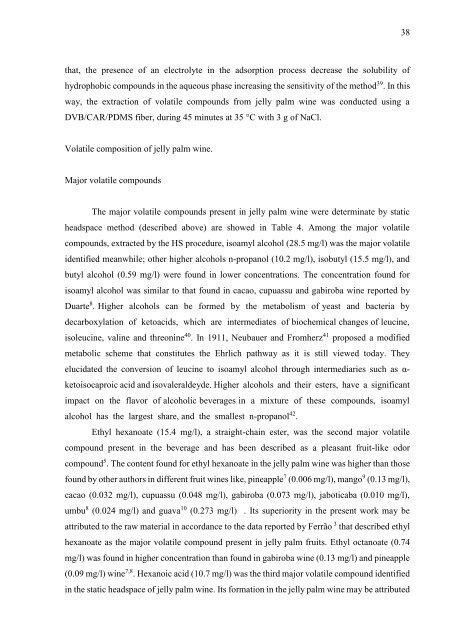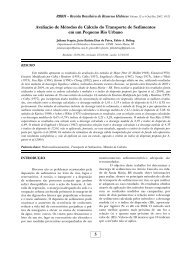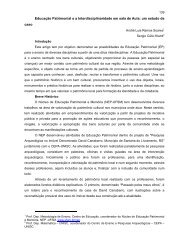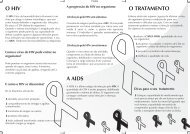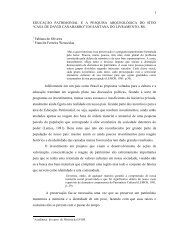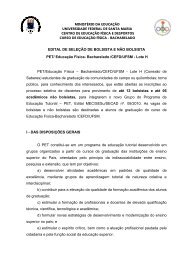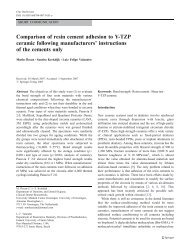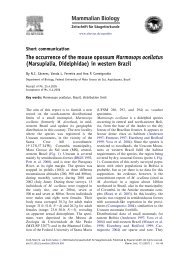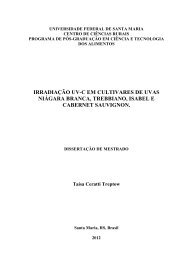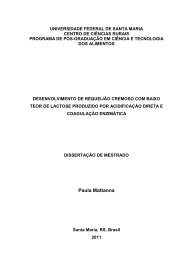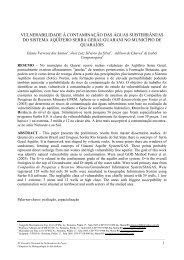DESENVOLVIMENTO E CARACTERIZAÇÃO FÃSICO ... - UFSM
DESENVOLVIMENTO E CARACTERIZAÇÃO FÃSICO ... - UFSM
DESENVOLVIMENTO E CARACTERIZAÇÃO FÃSICO ... - UFSM
Create successful ePaper yourself
Turn your PDF publications into a flip-book with our unique Google optimized e-Paper software.
38<br />
that, the presence of an electrolyte in the adsorption process decrease the solubility of<br />
hydrophobic compounds in the aqueous phase increasing the sensitivity of the method 39 . In this<br />
way, the extraction of volatile compounds from jelly palm wine was conducted using a<br />
DVB/CAR/PDMS fiber, during 45 minutes at 35 °C with 3 g of NaCl.<br />
Volatile composition of jelly palm wine.<br />
Major volatile compounds<br />
The major volatile compounds present in jelly palm wine were determinate by static<br />
headspace method (described above) are showed in Table 4. Among the major volatile<br />
compounds, extracted by the HS procedure, isoamyl alcohol (28.5 mg/l) was the major volatile<br />
identified meanwhile; other higher alcohols n-propanol (10.2 mg/l), isobutyl (15.5 mg/l), and<br />
butyl alcohol (0.59 mg/l) were found in lower concentrations. The concentration found for<br />
isoamyl alcohol was similar to that found in cacao, cupuassu and gabiroba wine reported by<br />
Duarte 8 . Higher alcohols can be formed by the metabolism of yeast and bacteria by<br />
decarboxylation of ketoacids, which are intermediates of biochemical changes of leucine,<br />
isoleucine, valine and threonine 40 . In 1911, Neubauer and Fromherz 41 proposed a modified<br />
metabolic scheme that constitutes the Ehrlich pathway as it is still viewed today. They<br />
elucidated the conversion of leucine to isoamyl alcohol through intermediaries such as α-<br />
ketoisocaproic acid and isovaleraldeyde. Higher alcohols and their esters, have a significant<br />
impact on the flavor of alcoholic beverages in a mixture of these compounds, isoamyl<br />
alcohol has the largest share, and the smallest n-propanol 42 .<br />
Ethyl hexanoate (15.4 mg/l), a straight-chain ester, was the second major volatile<br />
compound present in the beverage and has been described as a pleasant fruit-like odor<br />
compound 5 . The content found for ethyl hexanoate in the jelly palm wine was higher than those<br />
found by other authors in different fruit wines like, pineapple 7 (0.006 mg/l), mango 9 (0.13 mg/l),<br />
cacao (0.032 mg/l), cupuassu (0.048 mg/l), gabiroba (0.073 mg/l), jaboticaba (0.010 mg/l),<br />
umbu 8 (0.024 mg/l) and guava 10 (0.273 mg/l) . Its superiority in the present work may be<br />
attributed to the raw material in accordance to the data reported by Ferrão 3 that described ethyl<br />
hexanoate as the major volatile compound present in jelly palm fruits. Ethyl octanoate (0.74<br />
mg/l) was found in higher concentration than found in gabiroba wine (0.13 mg/l) and pineapple<br />
(0.09 mg/l) wine 7,8 . Hexanoic acid (10.7 mg/l) was the third major volatile compound identified<br />
in the static headspace of jelly palm wine. Its formation in the jelly palm wine may be attributed


